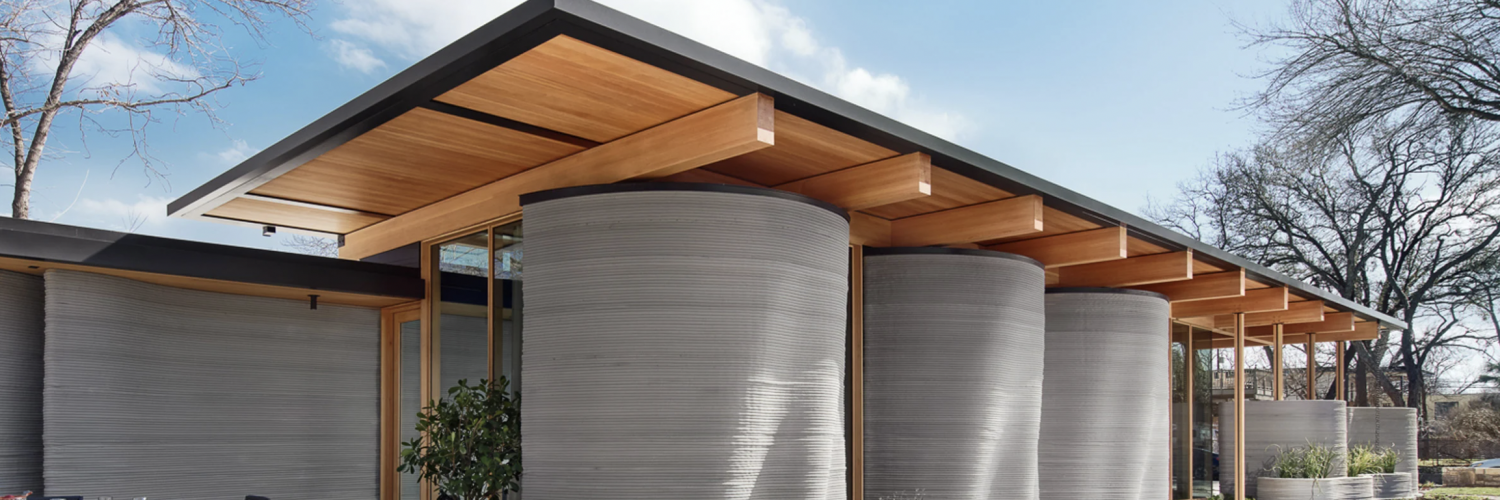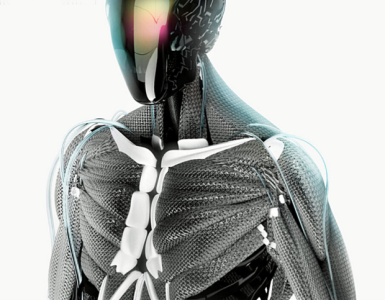Will homes ever become “print-on-demand”?
by A’liya Spinner
Mail-Order Home
Daniel clicked and dragged another rectangle across his laptop screen, adding it to a neat arrangement of shapes. With a tap of the mouse and stroke of a few keys, he added a label called “guest bedroom”, followed quickly by another conjoining rectangle he called “guest bath”. Once finished typing, he selected the program’s “preview” option and leaned back to inspect his handiwork.
The two-dimensional pattern of polygons began to render itself into a three-dimensional object. Rectangles grew into rooms, complete with doors and windows, stacking on top of themselves to create a digital model of a two-story house. The program rotated the model slowly on Daniel’s screen, giving him ample time to inspect it from every angle. Cost and time estimates popped up inside each room, all of which were— he was relieved to see— within his budget.
“How’s the house coming?” Daniel’s roommate suddenly asked, emerging from his room to sit at the table beside him. Estefan was a few years younger than Daniel, and not quite ready to buy a home of his own, but the novelty of the process intrigued him.
“Just finished,” Daniel answered, nodding in satisfaction. “It’s a good size for a good price. And if Stella thinks we need more space for the kids, we can always order an extra bedroom or two in a few years. They’re easy enough to tack on post-construction.” Stella— his fiancé— had relegated almost all of the initial designing of their home to him, while she looked around for the best interior installers of electricity and plumbing, as well as furniture and finishing. “In a week you’ll have the whole apartment to yourself— I’m ordering it as soon as Stella signs off.” Daniel downloaded the blueprint to his laptop and then opened his messaging app, sending it off to his fiancé for her final approval.
“A week?” Estefan leaned forward, peeking at the computer screen. “I thought these things were supposed to be like, instant.” He chuckled sheepishly, then. “Not that I’m eager to kick you out or anything.”
“Of course not,” Daniel answered sarcastically. “And you’re right— the house only takes a day to print at the factory. But Stella wants it built on-site so the electricians she picked out can work on it. Something about trusting human touch more than factory machines. She’s old fashioned like that.” He shook his head, not understanding the need for on-site installation when the fabricators could do the same work much faster, but also not really caring enough to argue about it.
“At least you save a lot on shipping,” Estefan offered. He’d listened to Daniel compare prices among 3D printer companies in the area enough to know just about how much everything cost in every scenario.
“That’s true.” With a nod, Daniel closed his computer and then stood, pushing his chair. “A week isn’t too bad, it gives me plenty of time to finish packing.”
Housing the Future
3D printing has come a long way in the thirty years since its advent, transforming from an inefficient and expensive fringe technology to a commonplace tool in medicine (printing prosthetics and hearing aids) and increasingly cheap resource for private consumption. Similar to inkjet printers, 3D printers work by depositing their own form of “ink” (made of molten polymers) in a flat pattern. It then stacks these 2D layers, fusing them together with adhesive and ultraviolet light. The result is a three-dimensional object. Colors and texture options are limited— but 3D printers are fast, reliable, and cost-effective. And while they’re predominantly used for small prototypes or machine parts, the technology has the potential for much larger applications. In fact, the first functional 3D printed house has already been built.
The company known as ICON recently constructed “House Zero” in Austin, Texas. The walls of the home were printed in only eight days, while insulation, wiring, and finishing took several months longer. ICON boasts that the uniquely curved walls of House Zero are structurally sturdy, as well as cheaper and faster to manufacture than traditional construction materials. At the end of the build, House Zero was safe, aesthetically-interesting, and ready to be lived in.
How Does This Help?
Companies like ICON believe that 3D printing will someday solve the housing crisis, and make homes affordable and available for younger generations. In just twenty to thirty hours, machines smoothly dispense enough concrete along computer-controlled patterns to create the barebones necessary for a fully functioning home. Even factoring in time for wiring, furnishing, window-installation, and other necessary, non-printable home components, this is much faster than the 6.8 month average time for traditional construction, and avoids many delays caused by supply chain disruptions and access to human labor. It also allows customers the freedom of designing and overseeing the making of their house without much additional effort or time commitment.
Alquist 3D, another company that’s begun 3D printing homes in the United States, has built a small number of houses for about 15% cheaper than traditional construction, and aims to lower that number to 30% by 2023. Unlike ICON’s House Zero, meant to show off the fullest capabilities of 3D printing, Alquist’s homes are already being lived in. By partnering with Habitat for Humanity, Alquist was able to provide a house for a low-income Virginia family, and they officially moved into their residence in early 2022. This was the first of many houses that Alquist hopes to provide to families who would be otherwise unable to afford them— both by building homes at a low enough cost that they can be sold for cheaper than wood-frame homes, and by reducing the extreme demand for houses that is driving up market prices. The company also boasts that the monthly mortgage payments on their home are low enough to be manageable for lower-income households, even after property taxes. Alquist additionally provided the Virginian family a personal and smaller-sized 3D printer that could be used to replace minor objects around the house, such as doorknobs or power outlets, making upkeep easy.
3D printing also promises to be more environmentally friendly than traditional construction. Alquist’s designs are EarthCraft certified to be energy, water, and resource efficient, and the layout and construction of the house aims to maximize comfort while keeping utility costs low. The speed at which 3D printed houses are created, as well as the reduction in wood materials and necessary manpower, keeps waste at a construction site minimal. Zachary Mannheimer, the founder and CEO of Alquist, has even stated that they are working with other firms to find an environmentally-friendly alternative to concrete for home construction, without endangering the structural integrity of his designs. Low-waste and green-material construction is not only better for the local environment, but helps to set a higher standard for the housing industry as it continues to evolve to match a growing and more eco-conscious population.
Unfortunately, 3D printing cannot directly address one of the major costs of construction— the price of land, especially in urban areas. However, it can keep overall costs down by building on plots considered “unfavorable” by traditional construction companies, either due to the location or the incline of the ground.
For some, like the small Oregon town of John Day, 3D printed houses may be the key to keeping the local population stable or growing; in John Day, the closure of timber mills sent the price of traditional homes and construction skyrocketing and led to a slow drain of inhabitants and families. The city signed a contract with developer Josh Walker to build 3D homes in land deemed unfavorable by contractors in hopes to return momentum to the town’s population.
In some urban environments, new land may not even be an issue to begin with. Although not currently the goal of any emerging companies, 3D printing in home construction is essentially the creation of new and solid walls, and thus old, derelict buildings can be removed down to their foundations and then rebuilt quickly and cheaply. This saves both land and helps refurbish neighborhoods in need of new and stronger infrastructure.
Commercial Application
Despite its increasing popularity in the housing market, few 3D printing companies have turned to making commercial buildings, such as office spaces or shopping centers. The first (and among the only) such 3D printed buildings— a new headquarters for the Dubai Future Academy— was unveiled in 2020, taking seventeen days to print, three months to finish and furnish, and costing only 50% of the manpower as traditional construction. While the building itself is functional, cost-effective, and waste-reducing, the scale of printer required may be the main factor discouraging further commercial construction. The printer used to make the Dubai Future Academy was 20 feet tall, 120 feet long, 40 feet wide, and had to be shipped in multiple parts from Shanghai and then assembled on site. For most companies, specially-ordering and assembling a machine of such proportions is not practical, and there may not be room on a crowded or urban construction site to operate a printer that large. Dubai’s ruler Mohammed bin Rashid Al Maktoum announced that the Dubai office building was meant to be a symbol of the UAE’s commitment to technological progress and leadership in sustainability; while a great symbol of innovation, commercial buildings are, as of now, too large and complex in scope to be reasonably constructed with the printers that most 3D printing companies have available.
Roadblocks on the Way
Clearly there must be barriers between our present level of technology and the normalization of 3D printing in large-scale home construction, or else we would already see this relatively quick and easy alternative taking over the industry. The most obvious reason we haven’t seen an influx of this scale, according to Alquist founder Mannheimer, is there simply aren’t enough suppliers to meet the demand for 3D printed houses. Alquist says they receive 25-30 requests for a commissioned home every hour, and that it would take upwards to fifty large-scale companies to make 3D printed houses a viable and commonplace option on the housing market. In the United States, there are currently less than ten such companies, and investors who are already involved with wood-frame housing are hesitant to back a cheaper alternative.
Furthermore, the housing industry itself makes 3D printed homes less practical to finish, despite the relative ease of initial construction. This is because modern methods of installing wiring, plumbing, HVAC, and other interior systems are completely based around traditional wooden frames— there is no well-trained workforce or blueprint for finishing 3D printed houses, which drives up the cost and timeliness of completion. A proposed solution to this lack of trained builders is to move construction off of the site altogether, and prefabricate the majority of the home in a factory, where embedding wires and other interior systems is much easier. Automation is also cheaper than hired workers and mobile printers, and prefabricated houses, like most 3D printed homes, are more energy efficient. Of course, factory production faces the same issues of supply and demand as on-site building, with very few facilities outfitted to print entire houses for shipping. Before 3D printed houses can become available for mass consumption, therefore, either significantly more infrastructure and companies must be created for printing homes, or the workforce specializing in the livable finishing of homes must learn a new skill set. Or, more likely, both will have to happen in order to streamline the process to commercially-available levels.
Outside Application
Many companies invested in 3D printing homes cite the housing crisis as a motivation for their innovation, seeking cheaper, faster, and more environmentally friendly methods to house the newer generation. Houses support families, autonomy, and owning a home is, in the long-term, cheaper than renting an apartment. And while there’s relatively little doubt that, in the United States, 3D printed homes will someday make a substantial impact on the housing market, housing shortages, resource depletion, and environmental degradation from poor neighborhood design and construction are global issues that extend far beyond the epicenter of 3D printer development.
For example, much of the appeal of 3D printed houses is that they can be built on-site with reduced pollution and waste; even homes built in factories and shipped to the final location require less time and ecological disruption to get finished in place. But it’s much more difficult to ship prefabricated walls overseas, or across hundreds to thousands of miles. 3D printers of the size necessary to pour concrete layers are also not easy to transport, nor are they cheap to manufacture, so companies will not be inclined to expand their operations until well established in the United States. With the help of nonprofits like Habitat for Humanity, perhaps 3D printers can be provided to people in need around the world, but the technology, as well as the resources needed to make it continuously function (concrete, or a more eco-friendly substitute), are not accessible to some of the nations and communities who need it most.
3D printing has the potential to revolutionize the housing industry in the domestic sphere, opening up new opportunities to a generation struggling to find affordable domiciles. With eco-conscious innovation and quick, cheap construction, 3D printed homes are already in more demand than current companies can supply, and those attractive qualities will only make them more popular in the future. However, difficulty of transport, as well as the front-loaded cost of buying and maintaining 3D fabricators, will probably keep 3D printing from being widely available in the place where it’s needed most; it may be several decades from its invention before the 3D printed house is able to make a positive global impact, but its effect in the domestic sphere will likely become increasingly obvious as younger, eco-conscious and money savvy generations begin to look for places to settle.





